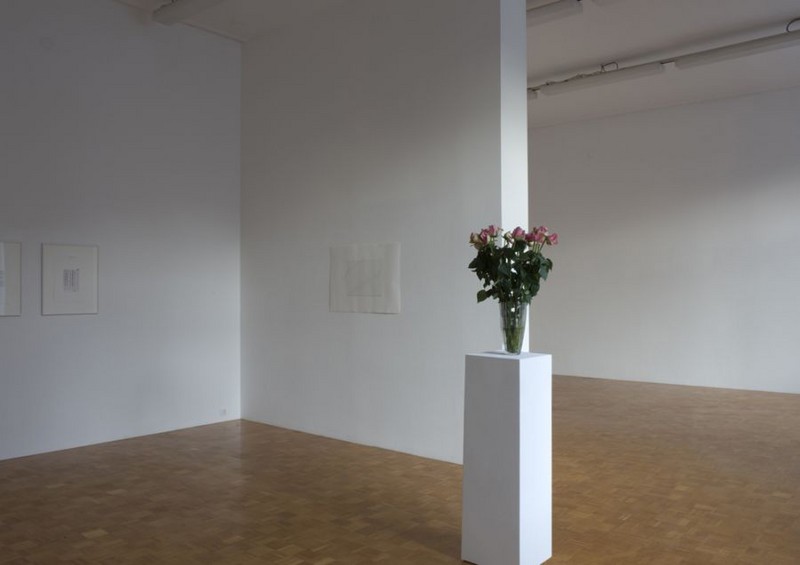Edith Dekyndt
13 Dec 2012 - 02 Feb 2013
EDITH DEKYNDT
The Painter's Enemy
13 December 2012 - 2 February 2013
Galerija Gregor Podnar and its Project Space / the DUM Association in Ljubljana is proud to announce Edith Dekyndt’s solo exhibition, The Painter’s Enemy.
Named after the Heuchera plant, which is also known in French as L’ennemi du peintre, or alternatively, le desespoir du peintre by virtue of its difficult to depict abundance and small blossoms, The Painter’s Enemy is the byproduct of a desire to create a still life. A conventional enough artistic impulse, especially for a northern European, one might say, but this is not just any still life. For akin to the eponymous plant from which the project borrows its name, it represents an unrepresentable abundance of material. Not only is it formed and informed by various strains of scientific and musical research, it seeks to register sonically, as opposed to visually. The elaborate, multi-faceted mechanism behind this still life is perhaps best descried by curator Anthony Kiendl, who originally commissioned the work for Contour 2011:
[In The Painter’s Enemy] Edith Dekyndt explores the notion of music as a sound inherently attached to biological forms, including flowers, and by extension human beings. In a short story from 1956, J.G. Ballard describes a future time, where humans have learned to hear melodies that plants spread around them. In 1990, physicist Joel Sternheimer found that a specific melody can stimulate or inhibit the synthesis of a protein within a living organism. When the patterns of plant molecules are transposed to a frequency audible to humans, plants can ‘make music’. Dekyndt has, working with a composer and arranger, transposed these ‘radio waves’ from certain flowers to a score for the theremin, the radio-frequency instrument made famous in Hollywood science fiction films.
"Belgian artist Edith Dekyndt has a most personal kind of methodical fascination for physical phenomena and ephemeral incidents. In her videos, audio pieces, installations and sculptural objects, she studies amongst other things light and sound waves, as well as minuscule particles without really manipulating them. Most of the time, she accelerates or decreases their recordings, or formally enlarges these elements to make them visible to the naked eye. The work of Edith Dekyndt concretely reveals itself as an attention paid to the factual and the presence of simple physical elements: her work draws on a form of minimalism and a conceptual visual language. It never aims at empirical results, but only at the presentation of these phenomena. Dekyndt’s artistic praxis implies more than a simple process of rationalization: her work continuously fluctuates between objectivity and experience."
Wim Waelput
The Painter's Enemy
13 December 2012 - 2 February 2013
Galerija Gregor Podnar and its Project Space / the DUM Association in Ljubljana is proud to announce Edith Dekyndt’s solo exhibition, The Painter’s Enemy.
Named after the Heuchera plant, which is also known in French as L’ennemi du peintre, or alternatively, le desespoir du peintre by virtue of its difficult to depict abundance and small blossoms, The Painter’s Enemy is the byproduct of a desire to create a still life. A conventional enough artistic impulse, especially for a northern European, one might say, but this is not just any still life. For akin to the eponymous plant from which the project borrows its name, it represents an unrepresentable abundance of material. Not only is it formed and informed by various strains of scientific and musical research, it seeks to register sonically, as opposed to visually. The elaborate, multi-faceted mechanism behind this still life is perhaps best descried by curator Anthony Kiendl, who originally commissioned the work for Contour 2011:
[In The Painter’s Enemy] Edith Dekyndt explores the notion of music as a sound inherently attached to biological forms, including flowers, and by extension human beings. In a short story from 1956, J.G. Ballard describes a future time, where humans have learned to hear melodies that plants spread around them. In 1990, physicist Joel Sternheimer found that a specific melody can stimulate or inhibit the synthesis of a protein within a living organism. When the patterns of plant molecules are transposed to a frequency audible to humans, plants can ‘make music’. Dekyndt has, working with a composer and arranger, transposed these ‘radio waves’ from certain flowers to a score for the theremin, the radio-frequency instrument made famous in Hollywood science fiction films.
"Belgian artist Edith Dekyndt has a most personal kind of methodical fascination for physical phenomena and ephemeral incidents. In her videos, audio pieces, installations and sculptural objects, she studies amongst other things light and sound waves, as well as minuscule particles without really manipulating them. Most of the time, she accelerates or decreases their recordings, or formally enlarges these elements to make them visible to the naked eye. The work of Edith Dekyndt concretely reveals itself as an attention paid to the factual and the presence of simple physical elements: her work draws on a form of minimalism and a conceptual visual language. It never aims at empirical results, but only at the presentation of these phenomena. Dekyndt’s artistic praxis implies more than a simple process of rationalization: her work continuously fluctuates between objectivity and experience."
Wim Waelput

